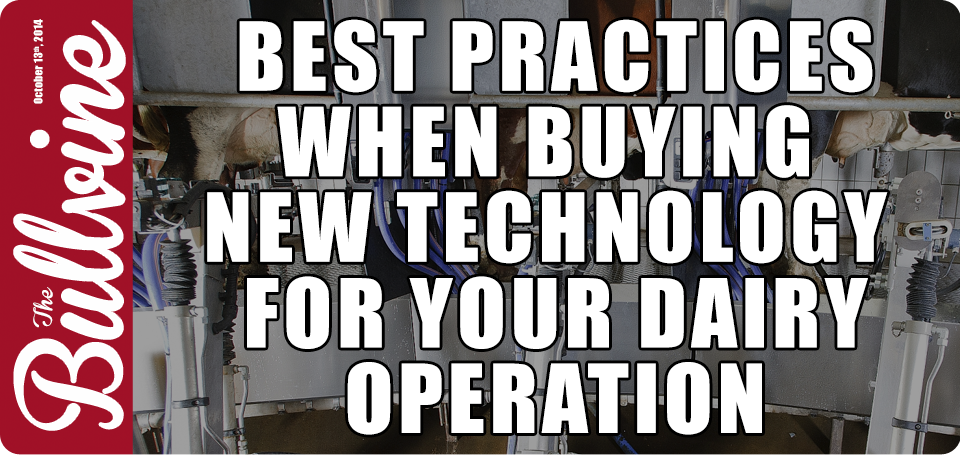Last week, while, at World Dairy Expo, I took the opportunity to attend a seminar presented by Jeffrey Bewley from the University of Kentucky. His topic was New Monitoring Technologies May Help Manage Cow Reproduction and Health. Before Dr. Bewley started I wondered what his take home message would be and if it would have been better for me to attend another seminar on breeding for feed efficiency. With more than one topic of interest going on simultaneously and not being able to clone myself, it meant that a choice had to be made. I will need to catch up on the materials shared on feed efficiency via electronic means however the ideas shared by Dr. Bewley struck a desirable note for me.
New Technologies Leading Change
Dr. Bewley started his presentation by stating “Technologies are quickly changing the shape of the dairy industry across the globe. In fact, many of the new technologies being applied to the dairy industry are variations of base technologies used in larger industries such as an automobile or personal electronic industries. These new technologies will continue to change the way dairy cattle are managed, bred and fed.”
Dr. Bewley’s presentation focused on numerous devices that are being connected simultaneously to cows in the University of Kentucky herd to measure performance, reproduction and animal health. Individual cows have more than one device attached to them so that the data captured can be inter-related. He strongly stressed that knowing single observations without knowing other measurements on a cow does not make the dairyman’s job easier. In fact, it makes it harder. Lots of data but no way of linking a piece of information from one device to another does not help make better decisions. In Dr. Bewley’s words “data is only useful if it translates into meaningful actions that herd managers can apply”.
Which Device(s) to Invest In?
The number of devices mentioned, by Dr. Bewley that the team at the University of Kentucky are testing was overwhelming. However, Dr. Bewley did provide thoughts on criteria for dairymen to use when deciding on equipment.
Ideal Technology
- Must be cost effective not just something that is nice to have.
- Needs to be flexible, robust and reliable (barns are harsh environments).
- Best if device is simple to use and the data captured is solutions focused.
- Information needs to be quickly available and user-friendly.
- Equipment supplier needs to be available 24/7 to troubleshoot.
Limitations
- New technology is not a fit for every dairy. Trial it before you buy it.
- Some devices are brought to market before they are fully field tested.
- Software is not always user-friendly. Test if it works for you.
- Some devices are developed and sold without consideration for work patterns on farm.
- Avoid stand-alone devices that cannot be linked to other on-farm technology.
How to Judge Benefits
- Will the information produced be more accurate than was previously available?
- Will the information provided save on labor costs?
- Will the information provided lead to increased profit per cow per day?
- Will the information result in improved product quality?
- When using the device will there be minimal environmental impact?
- Will your cows be healthier, have improved reproduction and be more profitable?
- Will managing the herd be easier and less time-consuming?
- If a device cannot provide at least two of the above benefits then don’t buy it!
Lessons Learned
Dr. Bewley and his team of researchers have focus on Precision Dairy Farming. Some of the lessons they have learned include:
- Be cautious about buying early stage technologies.
- Take the time to thoroughly learn how to use the technology and interpret the results.
- Integrating the data from the various on-farm technologies takes an expert.
- Having qualified customer service available is crucial.
- Give priority to buying devices that will have the largest impact on profit.
The Bullvine Bottom Line
The application of precision dairy farming technologies is important as herd size increases and margins narrow. A good place to get an objective view on technologies that apply to health and reproduction is the University of Kentucky website. Of course, another good source of information are breeders that have already installed the technology. Ask them both what’s good and what’s not so good about the device. By all means identify where your operation can be improved and then pencil out the cost – benefit of each technology. Applying technology will be a leading contributor to profitability and sustainability on dairy farms in the future.
Get original “Bullvine” content sent straight to your email inbox for free.
[related-posts-thumbnails]


















Leave a Reply
You must be logged in to post a comment.